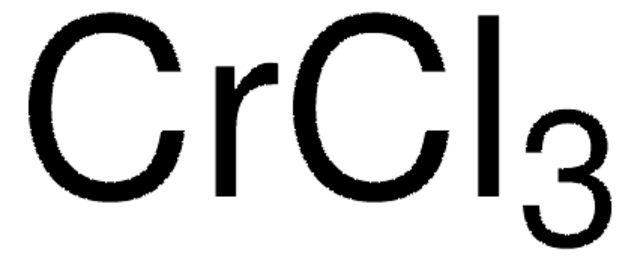529575
Cadmium chloride hydrate
99.995% trace metals basis
About This Item
Prodotti consigliati
Densità del vapore
6.3 (vs air)
Saggio
99.995% trace metals basis
Forma fisica
solid
Impiego in reazioni chimiche
reagent type: catalyst
core: cadmium
Impurezze
≤55.0 ppm Trace Metal Analysis
Densità
3.327 g/mL at 25 °C (lit.)
Stringa SMILE
O.Cl[Cd]Cl
InChI
1S/Cd.2ClH.H2O/h;2*1H;1H2/q+2;;;/p-2
OISMQLUZKQIKII-UHFFFAOYSA-L
Cerchi prodotti simili? Visita Guida al confronto tra prodotti
Avvertenze
Danger
Indicazioni di pericolo
Consigli di prudenza
Classi di pericolo
Acute Tox. 1 Inhalation - Acute Tox. 3 Oral - Aquatic Acute 1 - Aquatic Chronic 1 - Carc. 1B - Muta. 1B - Repr. 1B - STOT RE 1
Codice della classe di stoccaggio
6.1A - Combustible acute toxic Cat. 1 and 2 / very toxic hazardous materials
Classe di pericolosità dell'acqua (WGK)
WGK 3
Punto d’infiammabilità (°F)
Not applicable
Punto d’infiammabilità (°C)
Not applicable
Scegli una delle versioni più recenti:
Possiedi già questo prodotto?
I documenti relativi ai prodotti acquistati recentemente sono disponibili nell’Archivio dei documenti.
I clienti hanno visto anche
Articoli
Nanostructured Materials Through Ultrasonic Spray Pyrolysis
Colloidal quantum dots (CQDs) are semiconducting crystals of only a few nanometers (ca. 2–12 nm) coated with ligand/surfactant molecules to help prevent agglomeration.
Il team dei nostri ricercatori vanta grande esperienza in tutte le aree della ricerca quali Life Science, scienza dei materiali, sintesi chimica, cromatografia, discipline analitiche, ecc..
Contatta l'Assistenza Tecnica.











